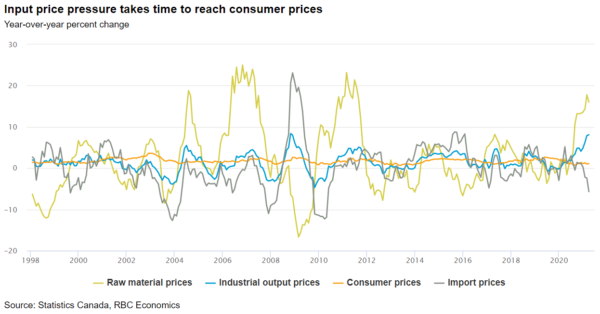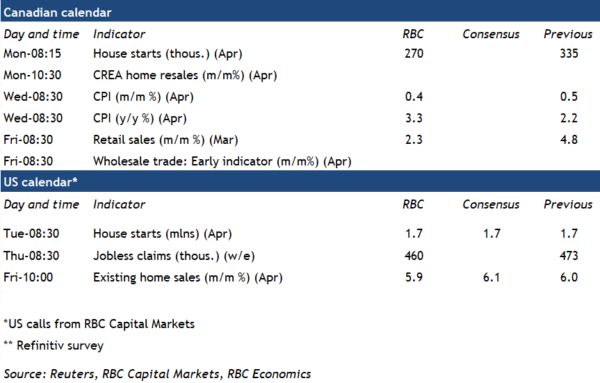We expect next week’s Canadian inflation report will show headline price growth jumped to 3.3% in April, in part reflecting lower bases last year when the economy closed down. Energy prices in particular came under signficant downward pressure last spring but have recovered such that gasoline prices were up 60% year-over-year in April. The Bank of Canada will look through transitory energy price swings, but signs of emerging underlying inflation pressures will be watched more closely. And we expect to see some of that in the report next week.
Broader measures of input prices have climbed in recent months. Raw material prices have surged for some products, and companies in the Canadian industrial sector have been passing those costs on with industrial output prices also up sharply. Still, it normally takes time for higher input costs to work through production chains and into consumer purchase prices. To-date, those price pressures have shown up more in Canadian export prices than domestic prices, aside from a handful of exceptions like much higher lumber prices. A stronger Canadian dollar has probably offset some of the near-term cost pressure on retailers. The price of consumer product imports was down almost 7% from a year ago in March.
Another concern is how quickly household demand could bounce back once the economy begins to re-open. Some services have been largely unavailable over the past year, and the price at which those services re-open could have a significant near-term impact on inflation measures. In Canada, COVID containment measures were still widely in place in April, but prices in the US spiked sharply as the economy began to reopen. We expect underlying inflation pressures in Canada to firm further as the year progresses, underpinned by a rapid recovery in consumer demand.
Week ahead data watch:
- Canadian retail trade is expected to increase in March as regions relaxed containment measures. We look to see re-imposed containment measures weigh down activity in April. Our internal card spending data is tracking a 4% decline in retail sales for the month.
- After exceptional strong activity in prior months early results showed Canadian home sales in major cities moderated in April. The country-wide report is expected to show sales slipped though remained at elevated levels in April.
- Active COVID cases have declined in most regions in Canada but some are still grappling with bringing the virus under control. Vaccine distribution, though, has continued to ramp up with over 41% of Canadians having received at least their first dose.













